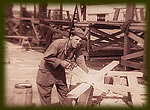 |
What
Style Is My House? by Ken Eklund February 2003 |
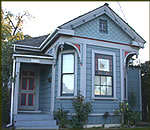 |
Victorian. This familiar style was popular from the 1860s or so until the turn of the century; it died out around 1910. Look for "gingerbread" - a plethora of little decorative bits of trim. This example is at 528 Fisk Avenue. |
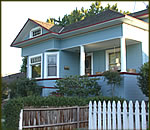 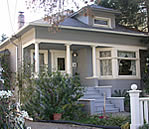 |
Neoclassical These houses show two very similar flavors: if the house seems more Victorian (asymmetrical and pronounced gables, for example) you can call it a "Queen Anne Cottage." If it seems more Colonial (symmetrical, with dormers rather than gables) then you can call it a "Neocolonial row house." The top example is a Queen Anne Cottage on Coe Avenue; note the pronounced gable above the bay window. The bottom example is a Neocolonial house at 568 Fuller Avenue. Both examples have Doric columns on the front porch, typical of the neoclassical style. |
|
Beginning in the early 1900s, several different "eclectic" styles of homes began to appear. Most of the homes in North Willow Glen were built between 1905 and 1940, and hold to one of these styles: |
|
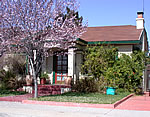 |
Colonial
Revival. If a home accentuates its central front door (especially with a portico or pediment) and is symmetrical (or nearly so), it's probably Colonial Revival. On the East Coast, the style is common and implemented more strictly; here on the West Coast, it's more freely mixed with elements from other styles. This example, at 565 Atlanta, has "hips" on its side-gabled roof (jerkin-head) which is a German style... but since it was built in 1925 (when anti-German sentiment was rampant in the U.S.) it was marketed as an "English Cottage." |
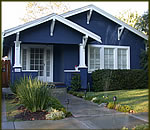 |
Craftsman. The Craftsman home has a solid look to it, with massive square porch pillars and hefty-looking jutting beams (usually faux). The Craftsman style was very popular before "The Great War" (and fading out during the 1920s). This Craftsman bungalow is at 369 Hull Avenue. |
 |
Mission. Mission-style homes have a decorative roof parapet that mimics those found on some Spanish colonial mission buildings from history. They usually have other Spanish architecture features, such as stucco walls and red tile roofs, as well. The style originated in California and was most popular between 1905 and 1930. This example is on Coe Avenue. |
 |
Prairie. Wide overhanging eaves and strong horizontal lines distinguish the Prairie-style home. It's a look many people associate with Frank Lloyd Wright, who was a master of the style. It's a relatively rare style, but we have a fine example of a Prairie home on the north corner of Bird and Brooks Avenue (595 Brooks). |
 |
Spanish
Eclectic. Spanish Eclectic-style homes have architectural details borrowed from the entire history of Spanish architecture. The style was made popular by the Panama-California Exposition of 1915 and peaked in popularity during the late 1920s and early 1930s. This excellent example is on the corner of Delmas and Marshall. |
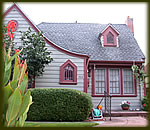 |
Tudor. You can identify a Tudor home by its sharply pitched (steep) roof and gables. This style exploded in popularity during the 1920s and early 1930s but fell rapidly out of favor in the late 1930s. The home shown is at 508 Fuller Avenue, one of a side-by-side pair of Tudor homes. |
| The depression of the 1930s and then World War II caused homes to become much more minimal in style and construction. | |
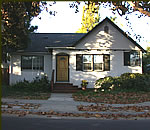 |
Minimal
Traditional. Homes built from 1940-1955 often echo the general form of a Tudor or Spanish-style home, but lack strong expressions or detailing. |
|
Ranch. |
|
| Copyright 2003 | |